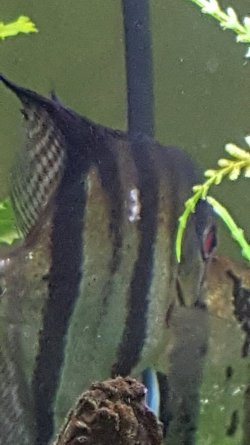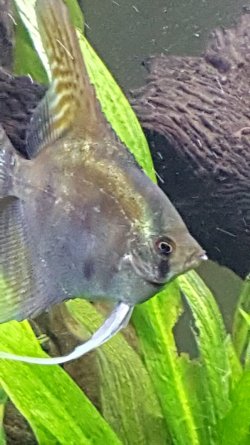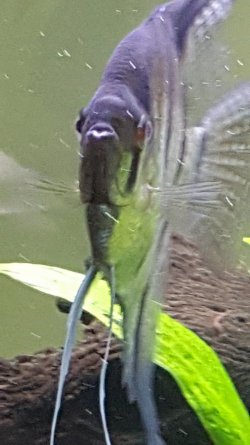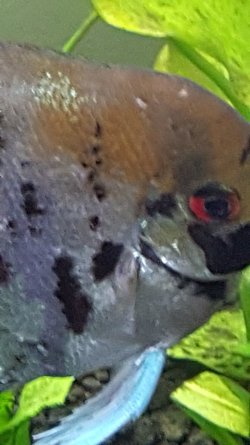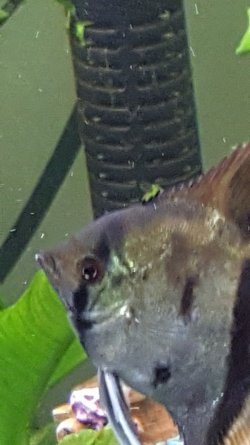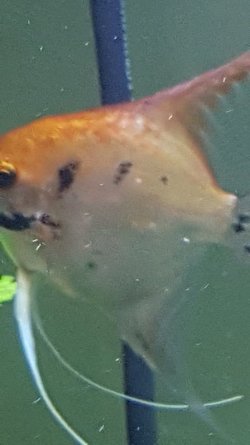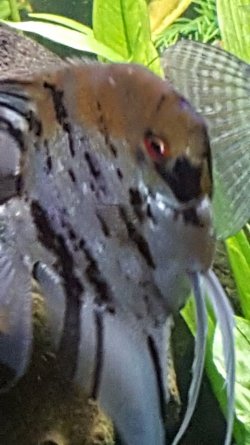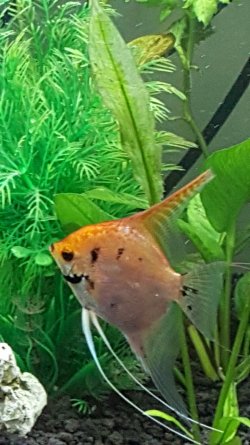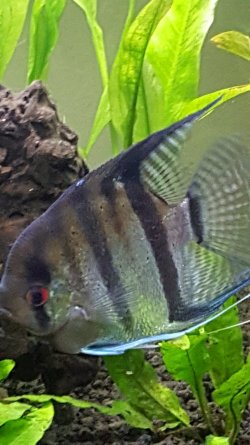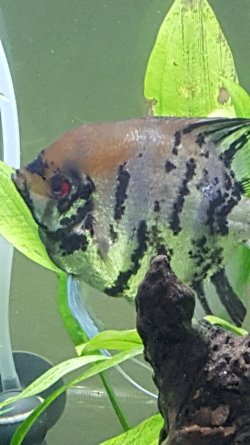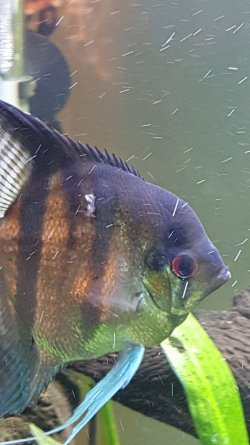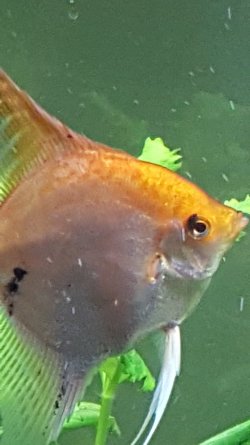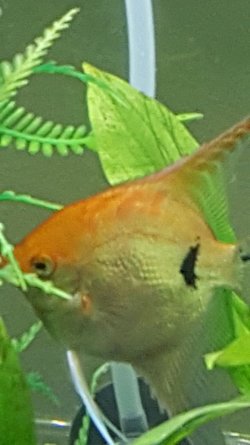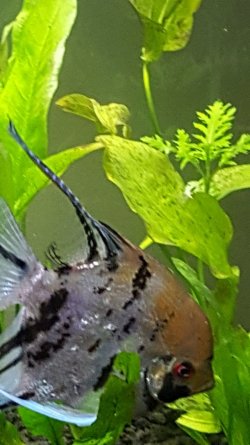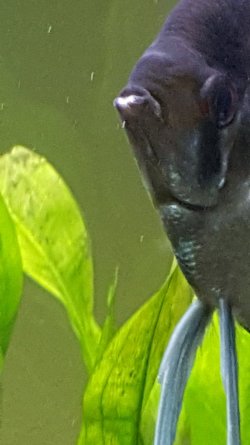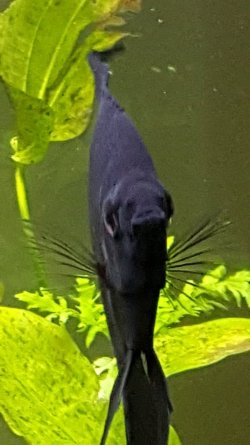Dragonswynter
New Member
Hi all, it's been a while since I've been on the forums. I finally was able to get my 55 gallon set up, only took me like 5 months, lol.
I have only fw angels, 3 juveniles, and now 3 adults, 1 ivory mystery snail - around a quarter's size, and 2 very small nerite snails. (Though I can only find 1). The angels transferred over from a very established 39 gallon. I used the filters, water and decor in the new 55 to help establish it. It's been set up for about 6 months now. I have several pieces of driftwood and quite a few smaller live plants in the tank also. Amazon swords, java ferns, Ocelot swords & a couple of anubias, . Everything has been peachy, aside from typical struggles for dominance. Nothing too severe, some damaged fins here and there, little bit of lip damage here and there, but no serious wounds. Put some melafix & pimafix in the tank to see if it helped. And either it really did a good job of helping repair the damaged fins, or it was a coincidental occurrence. Had done this a couple of times, and it seemed to work each time. Two of the adult angels were a breeding pair, together from very young, now about 2 yrs old. Very prolific breeders that had finally gotten it right this time and had fry swimming. I had no idea any eggs survived this time until I happened to see the wigglers! There was quite a lot of aggression, obviously. They were being amazingly good parents, keeping the fry very near and under close watch, and everyone else away. I saw some damaged fins on all, from the fighting and stress. Mostly the pectoral, a tiny "tear" on "daddy's " dorsal, so again I tried the melafix and pimafix. Almost immediately everyone was at the top of the water struggling. Did a partial water change right away, seemed to fix the issue. The remaining fry were eaten while the parents were back and forth at the top. Went to sleep for about 4-5 hours, woke up to my "momma" fish nose down in a bottom corner, dead. Everyone else back at the top again. Did another partial, hooked up an air pump and two diffusers to get some oxygen exchange going, so far so good, everyone else is doing well. Except I've now noticed some strange white spots on everyone. Bigger spots on the larger, but still there on the smaller. Can someone please help identify what this may be so I can treat accordingly?!
I did just over 50% water change yesterday. I have had a diatom issue in the tank, but otherwise it's a healthy tank. I keep up with regular maintenance, test often, parameters stay really good. Ammo always 0, nitrite 0, nitrate 0-10, has been as high as 30 (at which point another water change done). Ph is steady at 7.0. I do have hard water, but they've not seemed bothered by it. Gh 180-200-ish, kh is a tad low around 50. Temp stays a steady 78. Going to put up the best pics I have been able to take, and hope someone can help! Thank you in advance! I know it's a long post, but thought history may be a clue? I do think maybe some of what I am seeing could just be the coloring, esp on the gold koi, but there's definitely still something there. They do look better today than before I did the large water change. These are pics I took just now.
I have only fw angels, 3 juveniles, and now 3 adults, 1 ivory mystery snail - around a quarter's size, and 2 very small nerite snails. (Though I can only find 1). The angels transferred over from a very established 39 gallon. I used the filters, water and decor in the new 55 to help establish it. It's been set up for about 6 months now. I have several pieces of driftwood and quite a few smaller live plants in the tank also. Amazon swords, java ferns, Ocelot swords & a couple of anubias, . Everything has been peachy, aside from typical struggles for dominance. Nothing too severe, some damaged fins here and there, little bit of lip damage here and there, but no serious wounds. Put some melafix & pimafix in the tank to see if it helped. And either it really did a good job of helping repair the damaged fins, or it was a coincidental occurrence. Had done this a couple of times, and it seemed to work each time. Two of the adult angels were a breeding pair, together from very young, now about 2 yrs old. Very prolific breeders that had finally gotten it right this time and had fry swimming. I had no idea any eggs survived this time until I happened to see the wigglers! There was quite a lot of aggression, obviously. They were being amazingly good parents, keeping the fry very near and under close watch, and everyone else away. I saw some damaged fins on all, from the fighting and stress. Mostly the pectoral, a tiny "tear" on "daddy's " dorsal, so again I tried the melafix and pimafix. Almost immediately everyone was at the top of the water struggling. Did a partial water change right away, seemed to fix the issue. The remaining fry were eaten while the parents were back and forth at the top. Went to sleep for about 4-5 hours, woke up to my "momma" fish nose down in a bottom corner, dead. Everyone else back at the top again. Did another partial, hooked up an air pump and two diffusers to get some oxygen exchange going, so far so good, everyone else is doing well. Except I've now noticed some strange white spots on everyone. Bigger spots on the larger, but still there on the smaller. Can someone please help identify what this may be so I can treat accordingly?!
I did just over 50% water change yesterday. I have had a diatom issue in the tank, but otherwise it's a healthy tank. I keep up with regular maintenance, test often, parameters stay really good. Ammo always 0, nitrite 0, nitrate 0-10, has been as high as 30 (at which point another water change done). Ph is steady at 7.0. I do have hard water, but they've not seemed bothered by it. Gh 180-200-ish, kh is a tad low around 50. Temp stays a steady 78. Going to put up the best pics I have been able to take, and hope someone can help! Thank you in advance! I know it's a long post, but thought history may be a clue? I do think maybe some of what I am seeing could just be the coloring, esp on the gold koi, but there's definitely still something there. They do look better today than before I did the large water change. These are pics I took just now.

